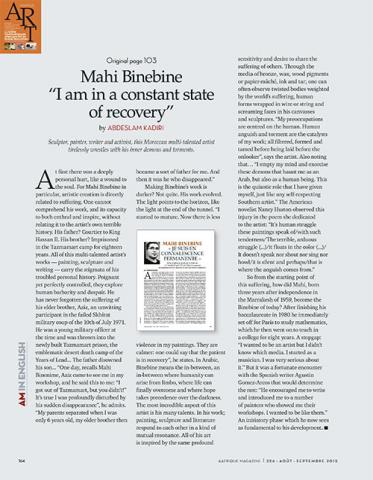“I am in a constant state of recovery”

Sculptor, painter, writer and activist, this Moroccan multi-talented artist tirelessly wrestles with his inner demons and torments.
At first there was a deeply personal hurt, like a wound to the soul. For Mahi Binebine in particular, artistic creation is directly related to suffering. One cannot comprehend his work, and its capacity to both enthral and inspire, without relating it to the artist’s own terrible history. His father? Courtier to King Hassan II. His brother? Imprisoned in the Tazmamart camp for eighteen years. All of this multi-talented artist’s works — painting, sculpture and writing — carry the stigmata of his troubled personal history. Poignant yet perfectly controlled, they explore human barbarity and despair. He has never forgotten the suffering of his elder brother, Aziz, an unwitting participant in the failed Skhirat military coup of the 10th of July 1971. He was a young military officer at the time and was thrown into the newly built Tazmamart prison, the emblematic desert death camp of the Years of Lead... The father disowned his son... “One day, recalls Mahi Binenime, Aziz came to see me in my workshop, and he said this to me: “I got out of Tazmamart, but you didn’t!” It’s true I was profoundly disturbed by his sudden disappearance”, he admits. “My parents separated when I was only 6 years old, my older brother then became a sort of father for me. And then it was he who disappeared.”
Making Binebine’s work is darker? Not quite. His work evolved. The light points to the horizon, like the light at the end of the tunnel. “I started to mature. Now there is less violence in my paintings. They are calmer: one could say that the patient is in recovery”, he states. In Arabic, Binebine means the in-between, an in-between where humanity can arise from limbo, where life can finally overcome and where hope takes precedence over the darkness. The most incredible aspect of this artist is his many talents. In his work; painting, sculpture and literature respond to each other in a kind of mutual resonance. All of his art is inspired by the same profound sensitivity and desire to share the suffering of others. Through the media of bronze, wax, wood pigments or papier-mâché, ink and tar; one can often observe twisted bodies weighted by the world’s suffering, human forms wrapped in wire or string and screaming faces in his canvasses and sculptures. “My preoccupations are centred on the human. Human anguish and torment are the catalysts of my work; all filtered, formed and tamed before being laid before the onlooker”, says the artist. Also noting that… “I empty my mind and exorcise these demons that haunt me as an Arab, but also as a human being. This is the quixotic role that I have given myself, just like any self-respecting Southern artist.” The American novelist Nancy Huston observed this injury in the poem she dedicated to the artist: “It’s human struggle these paintings speak of/with such tenderness/The terrible, arduous struggle (...)/it floats in the color (...)/It doesn’t speak nor shout nor sing nor howl/it is silent and perhaps/that is where the anguish comes from.”
So from the starting point of this suffering, how did Mahi, born three years after independence in the Marrakesh of 1959, become the Binebine of today? After finishing his baccalaureate in 1980 he immediately set off for Paris to study mathematics, which he then went on to teach in a college for eight years. A stopgap: “I wanted to be an artist but I didn’t know which media. I started as a musician. I was very serious about it.” But it was a fortunate encounter with the Spanish writer Agustin Gomez-Arcos that would determine the rest: “He encouraged me to write and introduced me to a number of painters who showed me their workshops. I wanted to be like them.” An initiatory phase which he now sees as fundamental to his development.